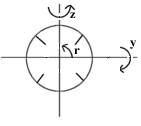
Definition An n-twist is applied to a tangle T by choosing an adjacent pair of ends and twisting them around each other producing n crossings, where n is an integer. eg a North 3-twist:

Definition A rational tangle is the
result of applying a sequence of twists (various directions) starting
with 0 or ![]() .
.
 From the symmetry in the definition it is clear that the dihedral
group of 8 elements D8=< r,y | ry =
yr3, r4 = 1 = y2> acts on the set of (isotopy classes of)
rational tangles, where r acts by rotation about the x-axis
through 900 and y is rotation through 1800 about
the y axis. Let x = r2. Let also z = xy then z acts by
rotation through 1800 about the z-axis.
The following is perhaps a little surprising.
From the symmetry in the definition it is clear that the dihedral
group of 8 elements D8=< r,y | ry =
yr3, r4 = 1 = y2> acts on the set of (isotopy classes of)
rational tangles, where r acts by rotation about the x-axis
through 900 and y is rotation through 1800 about
the y axis. Let x = r2. Let also z = xy then z acts by
rotation through 1800 about the z-axis.
The following is perhaps a little surprising.
Proposition x, y, z operate trivially on rational tangles.
Proof Since z = xy it
will be sufficient to prove that x and z operate trivially. Clearly
for one n-twist applied to 0 or ![]() the result holds. The proof now proceeds by
induction on the number of twists applied.
the result holds. The proof now proceeds by
induction on the number of twists applied.
Case i) If the twist is east or west then y
operates trivially, since we have yR = R by induction: ![]()
To see that z
operates trivially operate on zR by yn thus transferring
crossings from west to east say and use ynzR = R by
induction:
![]()
Case ii) If the n-twist is north or south then z operates trivially and y can be seen to operate trivially much as in case i).
Remark The operation on part of a knot or link
given by:
We now define a basic tangle (corresponds to rational
tangle in the lectures) to be a rational tangle obtained from 0 or
![]() by using only
south and east twists. By using flypes and the the proposition we can
convert west twists into east twists and north twists into south
twists. Hence we have:
by using only
south and east twists. By using flypes and the the proposition we can
convert west twists into east twists and north twists into south
twists. Hence we have:
Proposition Every
rational tangle is isotopic to a basic tangle. ![]()